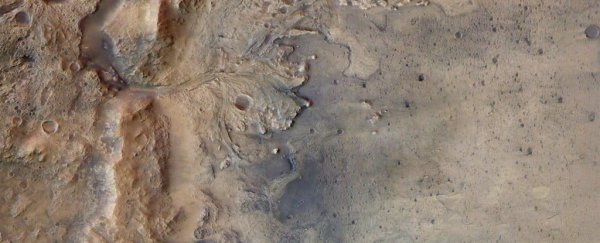It hasn't even been on Mars a full year, and NASA's Perseverance rover is making excellent surprise discoveries.
Amid a number of findings announced this week at the American Geophysical Union Fall Meeting, scientists have revealed that the Jezero Crater formed from molten volcanic magma – and that organic molecules have been discovered in rocks and dust on the crater floor.
This is by no means evidence for life on Mars. Organic compounds are simply those that contain carbon-hydrogen bonds, and these can form by any number of non-biological processes. Indeed, organic compounds have been discovered on Mars before, both by the Curiosity rover and the Mars Express orbiter.
But the finding does suggest that Mars rocks can preserve these compounds well, which in turn suggests that biological organic material could also be preserved. And that's pretty exciting.
"Curiosity also discovered organics at its landing site within Gale Crater," says planetary scientist Luther Beegle of NASA's Jet Propulsion Laboratory in Southern California. The detection was made using a new instrument on Perseverance called the Scanning Habitable Environments with Raman & Luminescence for Organics & Chemicals, or SHERLOC for short.
"What SHERLOC adds to the story is its capability to map the spatial distribution of organics inside rocks and relate those organics to minerals found there," explains Beegle. "This helps us understand the environment in which the organics formed. More analysis needs to be done to determine the method of production for the identified organics."

Perseverance landed on the red planet in February, in a region called the Jezero Crater. This place is thought to have once been flooded with water, and is rich in clay minerals – characteristics vitally important to Perseverance's mission. That's because, in a first for a Mars expedition, the rover has been tasked with looking for signs of ancient life; in our terrestrial experience, that's likely to occur near water.
In another first, the rover is equipped with 43 canisters in which it will deposit geological samples from Mars, to be retrieved and returned to Earth in a future mission called Mars Sample Return. Of course, those samples will be limited, so Perseverance is also equipped with a suite of scientific instruments to perform in situ analyses.
The SHERLOC instrument, for instance, was able to detect a combination of organic minerals in the Jezero Crater. These were not just in rocks that the rover abraded for the purpose of studying their internal contents, but in dust that coated the crater floor.
Another of Perseverance's instruments, the Planetary Instrument for X-ray Lithochemistry (PIXL), also allowed scientists here on Earth to learn the provenance of the bedrock in the Jezero Crater. After taking a core sample in a region nicknamed "Brac", PIXL's data clearly showed the presence of olivine crystals embedded in pyroxene crystals.
Here on Earth, such a mineral configuration is igneous in origin, suggesting that the floor of the Jezero crater formed from hot magma.
"A good geology student will tell you that such a texture indicates the rock formed when crystals grew and settled in a slowly cooling magma – for example a thick lava flow, lava lake, or magma chamber," says geochemist Ken Farley from the California Institute of Technology.
"The rock was then altered by water several times, making it a treasure trove that will allow future scientists to date events in Jezero, better understand the period in which water was more common on its surface, and reveal the early history of the planet. Mars Sample Return is going to have great stuff to choose from!"
We might have a while to wait for that; no launch date has currently been set for Mars Sample Return, and it's at least a year-long round trip to Mars, assuming everything goes smoothly, and not counting the time spent on Mars picking up Perseverance's sample tubes.
Even with limited instrumentation, however, the data Perseverance is sending home is invaluable to Mars scientists, both now and for planning future missions. And scientists are itching to get their hands on actual Mars rock, relatively freshly harvested, to complement studies of Martian meteorites that may have been altered on their journey to Earth.
"When these samples are returned to Earth, they will be a source of scientific inquiry and discovery for many years," says Beegle.
